Recent observations of twelve different stellar streams around the Milky Way have revealed the effects of dark matter, similar to how lights on a Christmas tree reveal the shape of the tree in dark. Plus, globular clusters, volcanoes, and an interview with Dr. Cathy Olkin from the Southwest Research Institute’s Lucy mission.
Podcast
Show Notes
First Chinese launch of the year
- CASC press release
Hunga Tonga-Hunga Ha’apai volcano erupts
- Tonga remains cut off after a massive eruption and tsunami. Here’s what we know. (CNN)
- The Tonga eruption explained, from tsunami warnings to sonic booms (National Geographic)
Volcanoes ended the Triassic Era
- Curtin University press release
- “Two-pronged kill mechanism at the end-Triassic mass extinction,” Calum P. Fox et al., 2022 January 5, Geology
Moon heated young Earth
- How Much Did the Moon Heat Young Earth? (Eos)
- “Habitability of the early Earth: liquid water under a faint young Sun facilitated by strong tidal heating due to a closer Moon,” René Heller et al., 2021 November 24, Paläontologische Zeitschrift
Stellar streams highlight dark matter
- Lowell Observatory press release
- University of Chicago press release
- University of Toronto press release
- “S5 : The Orbital and Chemical Properties of One Dozen Stellar Streams,” Ting S. Li et al., to be published in The Astrophysical Journal (preprint on arxiv.org)
Globular clusters revealed in new survey of Centaurus A
- The University of Arizona press release
- “NGC 5128 Globular Cluster Candidates Out to 150 kpc: A Comprehensive Catalog from Gaia and Ground-based Data,” Allison K. Hughes et al., 2021 June 9, The Astrophysical Journal
Transcript
Hello and welcome to the Daily Space. I am your host Dr. Pamela Gay.
And I am your host Beth Johnson.
Later on in the show, we’ll be joined by Dr. Cathy Olkin from the Southwest Research Institute, where she is the Deputy Principal Investigator for the Lucy mission to Jupiter’s trojan asteroids.
Now let’s put some science in your brain.
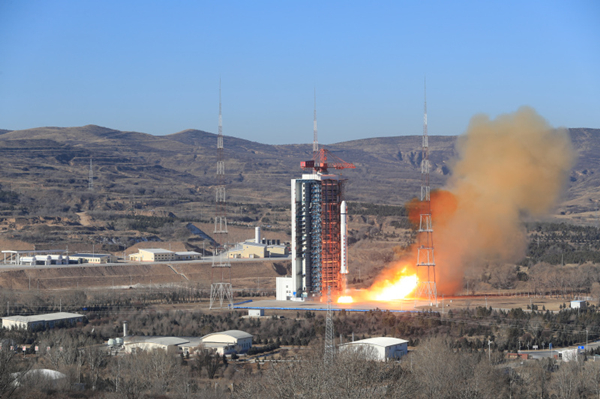
But before we get to that science, we have a rocket launch. On January 17 at 02:35 UTC, a Chinese Long March 2D launched the Shiyan 13 satellite from the Taiyuan Satellite Launch Center in China. Little information about the satellite was released beyond the usual “space environment detection and related technology experiments”, except for that it used a “two-meter satellite separation device” for the first time.
And now, we have science.
Today’s top story comes from our own planet Earth.
On Saturday, a massive volcano in the island kingdom of Tonga erupted with a force not seen since the 1991 eruption of Mount Pinatubo in the Philippines. Exact details on the eruption are still coming in, and we will be doing an in-depth story on this eruption later this week. What we know so far is that this mile-high ocean volcano is known to undergo massive eruptions about every 1,000 years, with the last massive eruption taking place between 1040–1180 CE.
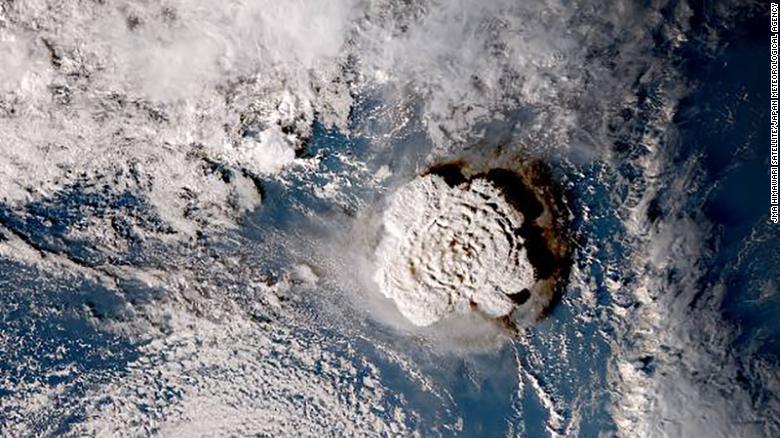
Saturday’s eruption initially ejected material more than fifteen kilometers or nine miles into the atmosphere and triggered a tsunami that caused damage as far away as the west coast of the Americas. Ashfall on the island is many centimeters deep, and this glass-sharp material will be, pound for pound, harder to remove than snow from even the worst nor’easter.
Details on the situation in Tonga are still scarce; the underwater cable that carries communications to Tonga’s main island was severed in at least two places, and it hasn’t been possible to land airplanes on the ash-covered runway.
While this volcano, from initial reports, was somewhat smaller in eruption than Mount Pinatubo, it was much better documented. Caught by a variety of different satellites, scientists have been watching its shockwaves move through the atmosphere. Again, we will be doing a more detailed report Thursday. For now, we’d like to say this is an ongoing event, and we don’t know what else may be in store, either from additional eruptive outbursts or from related ocean landslides and flank collapses. This is going to make relief efforts a challenge.
The science is amazing, but this is a populated area of the ocean, and real people are being deeply affected. If you want to learn how you can responsibly donate to relief efforts, please check out our website, DailySpace.org.
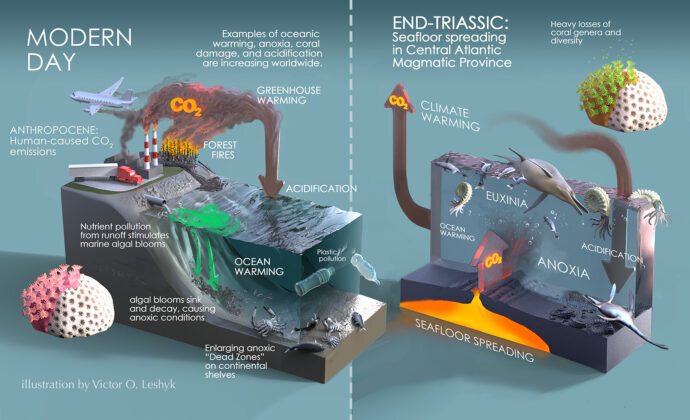
During our modern camera era, the Earth hasn’t been wildly active, and it’s easy to forget that past volcanic eruptions were capable of triggering global extinctions.
Over 200 million years ago, at the boundary between the Triassic and Jurassic periods, 23-34% of all marine genera disappeared and on land entire classes of animals, including many of the giant reptiles of the time, died off. Past research indicated this may have been caused by massive volcanic eruptions and the release of flood basalts, but the mechanisms for the marine die-off were unclear.
Now, in a new paper appearing in the journal Geology and led by Calum Fox, researchers detail the twin processes that could have killed off the Earth’s seas. According to Fox: These were a deadly combination of ocean acidification, which inhibited [the] growth of all marine life using calcium carbonate to create shells or body parts such as mussels, oysters, and corals, and rising levels of hydrogen sulfide in the ocean, which was extremely toxic for all marine life.
It all comes down to chemistry. At the end of the day, the gasses inside our world are toxic to the life atop our world.
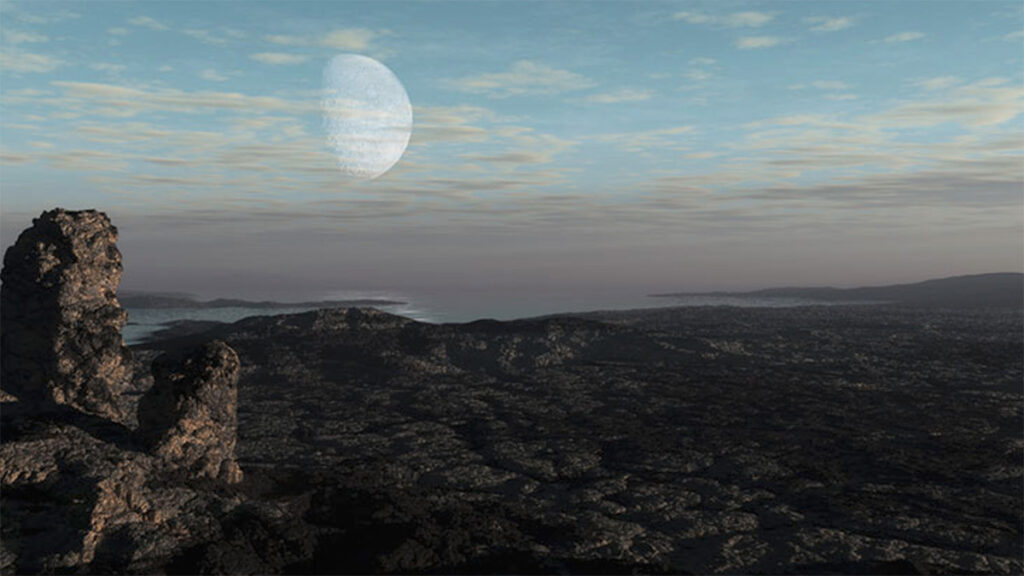
And if you are looking for something to blame for our overheated world, look no further than the Moon.
A new study published in Paläontologische Zeitschrift by Rene Heller and colleagues reminds us that the early Moon was significantly closer to the Earth – closer than modern-day geostationary satellites – and that Moon would have raised tides of rock within our Earth, heating our planet similar to how Io is heated by Jupiter. This would have warmed our world from the inside at a time when the Sun was still too cool to warm it from the outside and could have given our planet a headstart on life.
This paper has implications for other worlds as well. If Earth was made habitable by our Moon, does that mean early Venus and Mars, with their ocean climates, may not have been as well set up as Earth? For now, all we can do is hope that astrobiologists read this paper and publish answers quickly. When we know more, we’ll bring it to you here on the Daily Space.
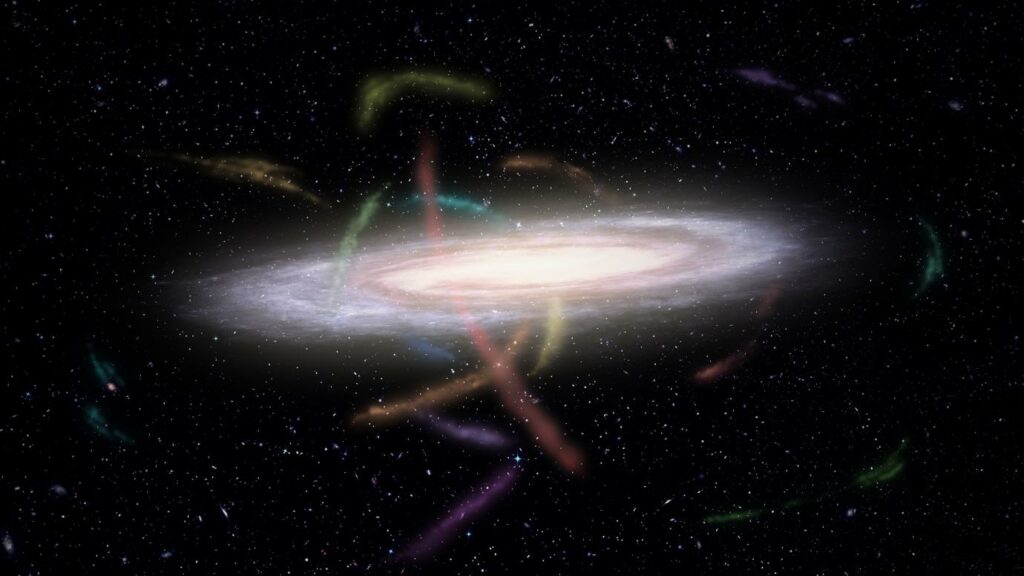
For the past couple of weeks, we’ve brought you stories on streams of stars that point toward our galaxy’s past consumption of dwarf galaxies that got too close. As we mentioned, it’s the time of year when, for whatever reason, these stories tend to come out, and today, we have a story that brings together all these streams to shape one really cool result.
A team of researchers led by Ting Li at the University of Toronto has used the Anglo-Australian four-meter telescope to perform the Southern Stellar Stream Spectroscopic Survey — a survey to measure the chemistry and detailed motions of the stars in twelve different stellar streams, which in turn reveal the effects of dark matter. Geraint Lewis, a collaborator on the project, explains it this way: Think of a Christmas tree. On a dark night, we see the Christmas lights, but not the tree they are wrapped around. But the shape of the lights reveals the shape of the tree. It is the same with stellar streams – their orbits reveal the dark matter.
This paper appears in The Astrophysical Journal, and according to the abstract: The velocity and metallicity dispersions show that half of the stream progenitors were disrupted dwarf galaxies (DGs), while the other half originated from disrupted globular clusters.
By looking at the chemistry and motions of these streams, they also start to hint at how some streams and some not-destroyed objects in the galactic halo may be related to specific streams. This is an ongoing project, and we look forward to seeing more details published over time.
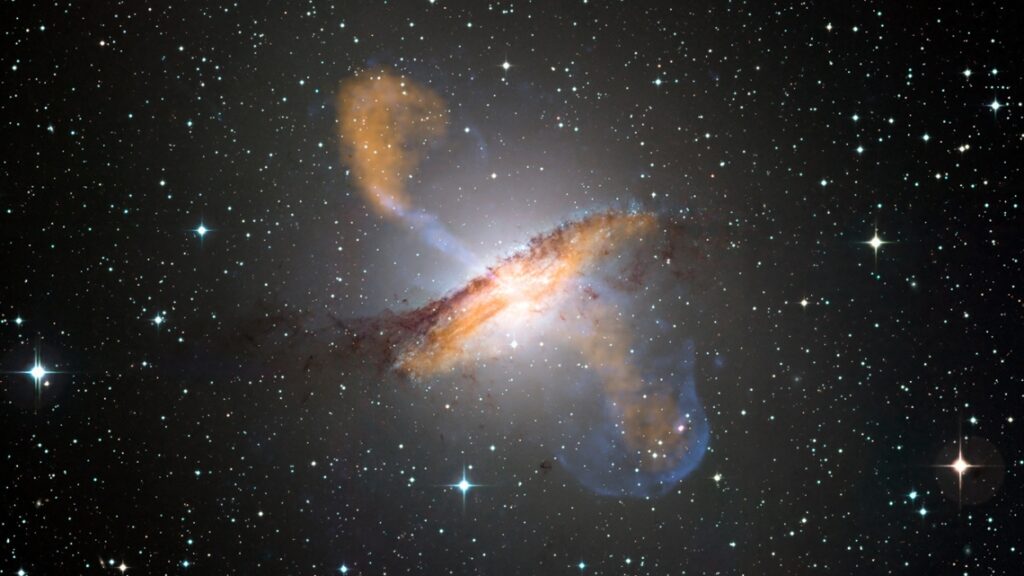
Globular clusters are simultaneously one of the most consistently boring-looking objects in the sky and one of the most scientifically useful. You can use them to understand our galaxy’s history, and now, thanks to giant telescopes, they can also be used to understand the evolution of other galaxies.
These spherical collections of stars seem to form in a single burst of star formation under very specific conditions, such as in the shocked gas of merging galaxies. Large galaxies like our own have clusters that may have formed in situ and clusters that definitely formed elsewhere and were then stolen.
A new survey of the giant, active galaxy Centaurus A documents the locations of 40,000 globular cluster candidates and recommends studying nearly 2,000 of the best ones. These clusters are within roughly 500 thousand lightyears of the galaxy center, and this is the first time a survey has looked to this great a distance.
By confirming clusters, researchers will be able to better understand the merger history of this clearly disrupted system. As explained by Allison Hughes, the first author of an Astrophysical Journal paper on these results: Globular clusters are interesting because they can be used as tracers of structures and processes in other galaxies where we can’t resolve individual stars. They hold on to chemical signatures, such as the elemental composition of their individual stars, so they tell us something about the environment in which they formed.
She goes on to further explain: If you see a line of these globular clusters that all have similar metallicity (chemical composition) and move with similar radial velocity, we know they must have come from the same dwarf galaxy or some similar object that collided with Centaurus A and is now in the process of being assimilated.
It’s a galaxy-eat-galaxy universe out there.
Let’s be honest. It’s a galaxy-eat-galaxy, protoplanet-hit-protoplanet, and randomly rearranging solar system out there. And thanks to the new Lucy spacecraft, we’ll be able to get a better understanding of some of the more local chaos.
Interview
Joining me now is Dr. Cathy Olkin from the Southwest Research Institute. Dr. Olkin is the Deputy Principal Investigator for the Lucy mission, which launched on October 16, 2021. Lucy will be the first space mission to explore a population of small bodies known as the Trojans, which orbit ahead of and behind Jupiter in the gas giant’s L4 and L5 Lagrange points.
Thank you for joining us, Dr. Olkin.
[Transcript unavailable]
This has been the Daily Space.
You can find more information on all our stories, including images, at DailySpace.org. As always, we’re here thanks to the donations of people like you. If you like our content, please consider joining our Patreon at Patreon.com/CosmoQuestX.
Credits
Written by Pamela Gay and Beth Johnson
Hosted by Pamela Gay and Beth Johnson
Audio and Video Editing by Ally Pelphrey
Content Editing by Beth Johnson
Intro and Outro music by Kevin MacLeod, https://incompetech.com/music/


 We record most shows live, on Twitch. Follow us today to get alerts when we go live.
We record most shows live, on Twitch. Follow us today to get alerts when we go live.